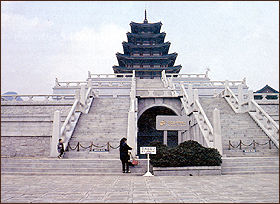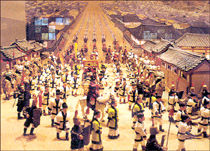|
|
|

The National Folk Museum
the place where you can see the life of Korean ancestors

hen you walk around Kyongbok-gung
Palace, a building built with white marble and blue roof draws attention.
This is National Folk Museum, where all the documents that Korean ancestors
recorded are preserved. The museum is located inside Kyongbok-gung Palace,
and it is lively culture center where you can experience Korean traditional
culture and life style of Chosun Dynasty(1392-1910).
The exhibition at National Folk Museum is divided into
regular and special exhibitions, and the regular exhibition is further divided
into indoor and outdoor exhibitions, which all the visitors can see. The
first exhibition hall is called, "Korean People's Life and Culture Hall".
A brief introductory summary of Korean history and historical implication
on Korean culture leads to the real life tools from pre-historic ages and
Samguk Period(BC57-935), printings and porcelains of Koryo Period(935-1392),
technology and Hangul of Chosun Period, and other pieces, which respresent
Korean people, are duplicated and exhibited. The second exhibition hall
is "Life and Material" and explains the life of farming, fishing, hunting
and all the life styles, which are the basis of the life of Korean people
today. Also, craft, weaving, and dye works are exhibited here, which explain
the economy of Korean people at that time.
|
|

|
|
The third exhibition hall is called, "The Life Time of Korean", and it displays the life time rituals, which every Korean encounters from the moment of birth to death. This hall exhibits all the social encounters that a person experiences throughout the life time, and as such you can understand the life of Korean people better. For instance, exhibitions include children's plays, stationery shops, schools, folk superstitions, traditional plays, and the social structure.
Besides, through the regular exhibitions, National Folk Museum offers chance to meet Korean culture and life style, and focused on themes like the structure of Korean thinking, crafting skills, and arts, it holds special exhibitions with aid of materials from other museums and its own.
Information
|
How to get there : Exit 5 of Kyongbok-gung station line number 3 or exit 2 of Kwanghwamun station line number 5, and the museum is 15 minute walk away.
Opening Hours : 09:00-18:00(Closed on Tuesday)
Admission Fee : 25-64 years old 700won, 19-24 years old 300won
Tel : 02-734-1346
Website : www.nfm.go.kr
|
|
|
A special exhibition, "Hangang, the Mother of Korean People" at National Folk Museum tells the past and present of Han river" as it symbolizes the mother nature of Korean people. This exhibition is held in special hall, folk media hall, and outdoor hall, and Han river related materials such as, 500 pieces of remains, 200 photos, and media display will be exhibited until October 29th.
The miniature models of Anapji, Hwang Ryong Sa 9-floor Tower, and Geunjeongjeon of Kyongbok-gung Palace from Shilla Period(one of the three nations when Korea was divided into three) are attractions of this folk museums as well. There are other exhibition displays around the museum, such as Cheonhadaejanggun and Jihayeojanggun(protecting deity stationed at the village entrance), Dolharubang(a grandfather figure carved out from granite, which is believed to be deity of Cheju-do), and Yeonjabang-a, which are definitely worth look.
(Sourced from WHAT'S ON SEOUL)
|
|
|